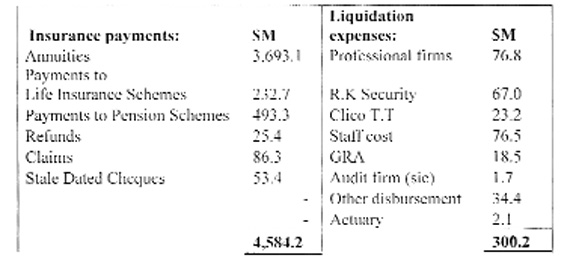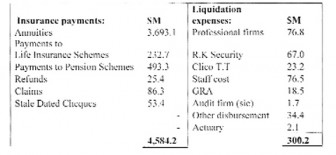Conclusion
Introduction
Today completes a series on the liquidation process of the insurance giant that collapsed spectacularly in early 2009 after news came out of Trinidad and Tobago that the company’s parent had been taken over by that country’s central bank following a dramatic run on the company mainly by policyholders. As we looked with amazement at the manoeuverings of those involved including President Jagdeo, Drs Ashni Singh and Roger Luncheon and Ms Maria Van Beek and Ms Geeta Singh-Knight we learnt that the Guyana subsidiary was resting on a foundation of sand, that the company had been managed recklessly, and that the regulator had failed to do its job. Then we saw what the Insurance Act and the Companies Act had intended, namely, to regulate the orderly liquidation of a failed business, turn into a series of legal and professional infractions.
This series of three parts began following the lodging of a Liquidator’s Statement of Receipts and Payments more than one year beyond the statutory deadline. If readers thought the elementary errors in the preparation of the statement by the liquidator and his team were bad, they must now confront worse. If the high priced professionals knew what they were doing, it is not reflected in their work. Their carelessness, shoddiness and poor standard of work have done nothing to minimise, let alone reverse the massive losses to Clico’s creditors, the NIS and the country.
Today’s Business Page concludes its short series with the regret that when the government prefers loyalty to competence, all we end up with are avoidable losses and lessons from which we do not learn. 
Source: Statement lodged with the Registrar of Companies
Earlier, I had reproduced the Liquidator’s Statement of Account in which Mr Williams misleadingly described total receipts as ‘Realisations‘ and separately, disclosed those payments in relation to Insurance transactions and those he described as Liquidation Expenses. For the purpose of this instalment, I think readers might find the information in the table set out above of some assistance in understanding how the liquidator has conducted the financial transactions for the period for which he has made a report.
Insurance payments
But before turning to those payments, a general comment on the $4,584.2 million in insurance payments. The information lodged with the Registrar shows only the classes of the payees. There are no supporting schedules or particulars. As a result there can be little commentary on those payments and whether for example the NIS, by far the company’s major annuitant, has so far received any cash from the liquidator. But the NIS is not the only creditor which has been made to sweat, despite the key role being played in the liquidation by their long-serving director Mr Maurice Solomon, a member of Williams’s triumvirate.
NIS massive losses
Whatever duty Mr Solomon may consider he owes the NIS, he appears to have done very little to protect or speak up for the tens of thousands of pensioners and other beneficiaries who are staring at the loss of billions of dollars of NIS investments in Clico. Worse, the famous assurances by Drs Jagdeo and Luncheon that the NIS would get back all its money have so far proved to be no more than the idle words of insincere politicians. On his part, Mr Solomon has annually approved financial statements of the NIS which make no provision for the losses which the NIS is already incurring, as it looks helplessly at its financial statements and sees over $5,000 million of investments in Clico producing no income and on a balance of likelihood, having to be written off sooner rather than later.
This is not scaremongering. The information provided in the June 2012 statement, the first filed by the liquidator since his appointment nearly two years ago, is hopelessly deficient to allow for proper analysis; well outside of the statutory deadline; uninformative about the current financial status of the company; and useless when it comes to assessing the prospects for the remaining creditors. What I know based on professionally prepared information collected in 2009 is that the total liabilities of Clico at the date of the appointment of the liquidator amounted to close to $15 billion. At June 30, 2012, just under $5 billion had been paid towards those liabilities leaving around $10 billion to be paid towards the capital sums outstanding, since interest is out of the question.
Already it seems that some $600 million will be paid to the NIS by way of an effective exchange of property in part settlement for its debt. That will leave little else for them or for the other creditors. In other words, as things stand the NIS is likely to lose over $5 billion, and other creditors, whose names are known by the liquidator but who have not been listed, will lose around $4 billion.
Liquidator’s expenses
Now let us turn to an amount of $301 million referred to by Mr Williams and his team as ‘Liquidator’s expenses.’ Because of the amateurishness in the preparation of the statements, a review or comment has to make certain assumptions or consider certain possibilities. For example, it is hard to believe that the payment to RK’s Security of $67.0 million could possibly be for the period since the liquidation, and one wonders what it would have taken for the liquidator to state the period to which the payment applied.
This is not simply amateur accounting. It has legal implications. When an entity goes into liquidation, the law provides a scheme for the payment of debts, starting with preferential creditors. Charges by RK’s Security prior to the liquidation are not priority debts and it must be assumed therefore that the $67 million was paid for services received after Williams’ appointment. Surely these must be justified by way of proper disclosure.
Another interesting item is that relating to taxation. The sale of properties gives rise to potential capital gains tax while payments made to non-residents may be subject to withholding tax. My experience is that a number of accountants, in carrying out receiverships and liquidations, routinely overlook their obligations under the tax laws. So before Mr Williams undertakes another transaction with tax implications, he should invite the GRA to examine his stewardship’s compliance with the tax laws.
The unnamed professional firms
Returning to the statement, the most startling item is the sum of $76.8 million paid to “professional firms,” a term, which obviously rules out both Mr Williams, and Ms Gibson, a member of his supporting cast. So how does Mr Williams explain the $76.8 million paid to “professional firms,” which perhaps not surprisingly, he does not identify? He gives not a least hint. What we do know is that this sum cannot include any payment to the actuary since that is separately itemised with its own amount ($2,123,815). It cannot be audit since that too is separately itemised with its own amount ($1,740,000). It cannot be for valuation services since that is also separately identified with its own amount ($3,110,215). Mr Williams the liquidator, Ms Gibson, the actuary, the valuer and the auditor having been eliminated, one is left only with the providers of legal and accounting services.
The accountants and the lawyers
Based on the public records, legal services, including conveyancing and litigation work, were provided mainly by the law firm of Mr Ashton Chase SC. In accounting, Nizam Ali and Co prepared for then Commissioner of Insurance Maria van Beek, a statement of net assets at February 28, 2009 and Mr Maurice Solomon provides to the liquidator, services such as cheque-signing. Since Clico retained the services of CEO and Chartered Accountant Geeta Singh-Knight as well as key accounting personnel of the failed company, all of whose emoluments are accounted as staff cost, the $76.8 million paid to “professional firms” seems hardly justifiable.
Adding insult to injury, the liquidator, possibly on the advice of Ms Geeta Singh-Knight paid some $23.2 million to a company that is part of the group which cheated Guyana of some $7 billion.
Conclusion
Ever since the matter of Clico surfaced in Guyana following the collapse of its parent in Trinidad and Tobago, Guyanese have been subject to misinformation, distortions and silence. Guyanese reacted favourably to the false assurances and actually praised President Jagdeo for helping out with money he negotiated from the Petroleum Fund and from raiding the Forestry Commission of moneys that should have been paid into the Consolidated Fund.
Informed opinion thought otherwise. That group wanted an investigation and prosecution of the directors of Clico as contemplated by the Insurance Act and the criminal laws. The Commissioner of Insurance had the power to appoint a Special Prosecutor to pursue any wrongdoing. But her failure to do so, her rush to liquidation and her appointment of Ms Geeta Singh-Knight to continue in the management of the company were as mysterious as her subsequent shooting in downtown Georgetown.
Some of us felt that the move to have a liquidator appointed premature; they were convinced that certain of Clico’s business not only could, but also should have been saved in the public interest. They were not only ignored but also ridiculed.
We are the only country that made no attempt to save the salvageable parts of the company. Indeed Trinidad, which was the worst hit, is now being rewarded with a Clico that is reporting improved performance and a significant rise in its assets value. As the financial press in that country reports earlier this month, Clico’s portfolio of listed investments is now worth T&T$6.3 billion. We ought to have been in a position to make a case against the Trinidad and Tobago parent. Jagdeo’s rushed deal to extract money from the Caricom Petroleum Fund probably ruled that out.
While the company may have some time to go before it is finally dissolved, the chances of any inquiry are not high since neither the government nor the opposition seems to have any interest in the fate of the company. Given the consequences for the NIS – a potential loss of more than $5,000 million – their lack of interest is a shame. They must insist on a full inquiry. Compare our situation with Trinidad where their central bank Governor on Thursday September 6 admitted to public perceptions that the Bank faltered in relation to its supervision of Clico; that there is likely to be psychological damage from the Clico failures; that the Bank would be subject to the first Commission of Inquiry in its 48 year history; and that the Bank would be transparent in accounting for its regulatory and supervisory actions in respect of the Clico companies.
The bunglers who are administering the Guyana Clico have allowed Caribbean Resources Limited to be dissolved without pursuing the $1.5 billion which CRL owed to Clico. Mr Lawrence Williams has double the obligation of his Trinidad counterpart. The Guyana central bank messed up big time when it failed to challenge Clico’s marketing of deposits masquerading as insurance. Now as liquidator, its Governor and its head of the Insurance Supervision Department are botching the company’s liquidation.











